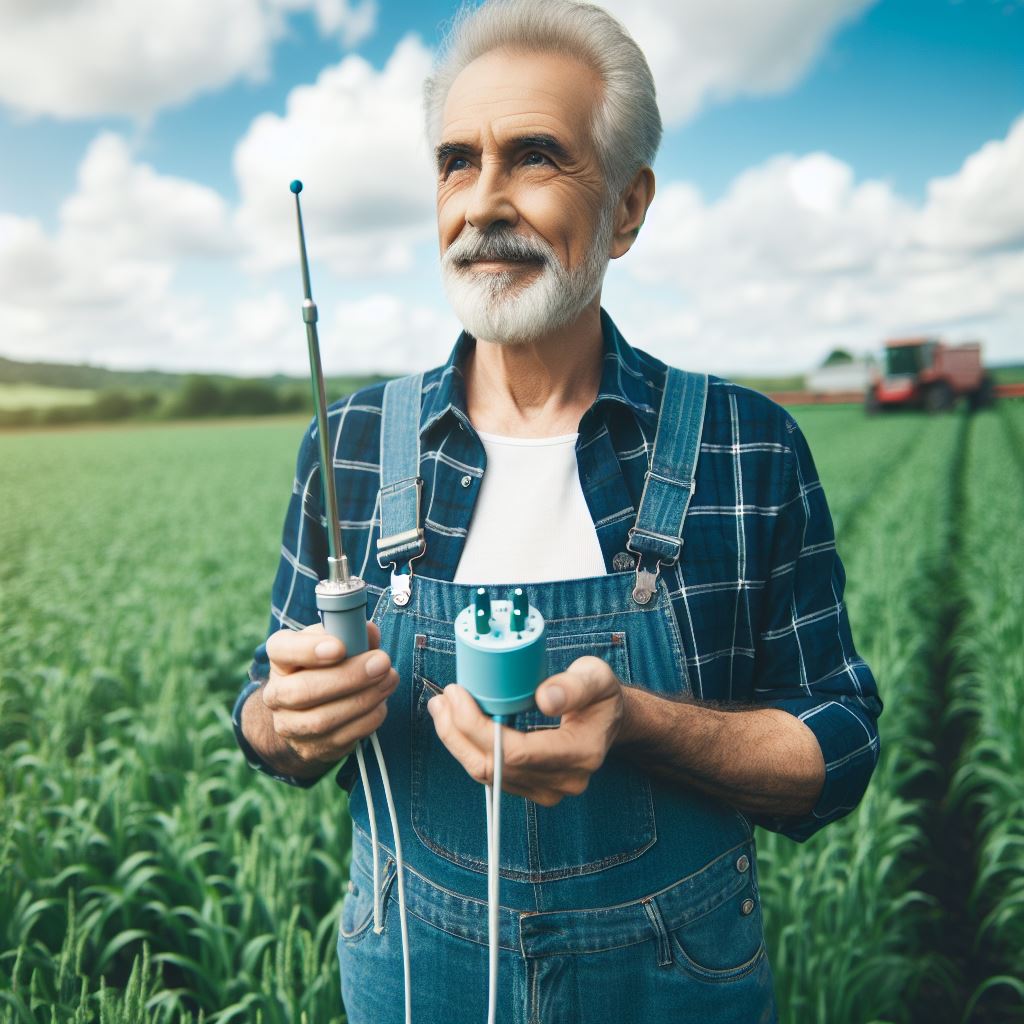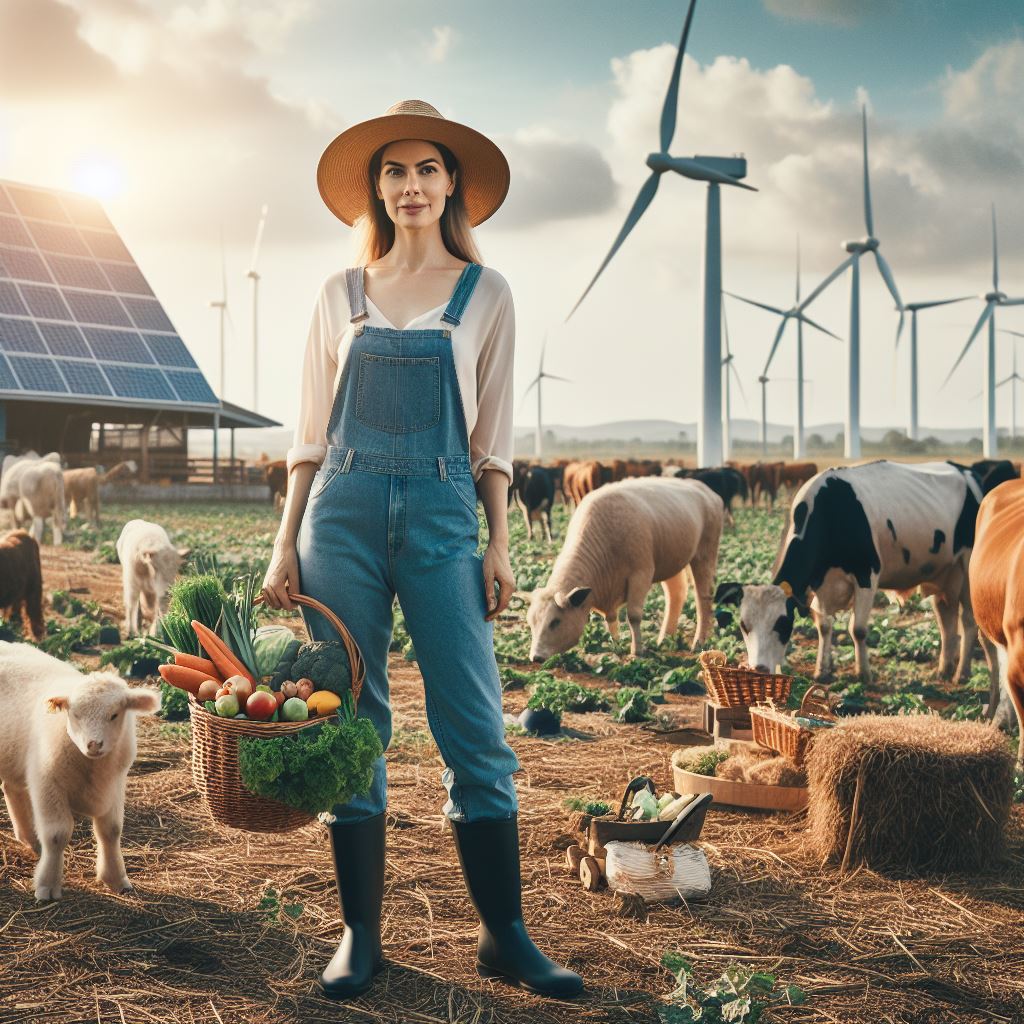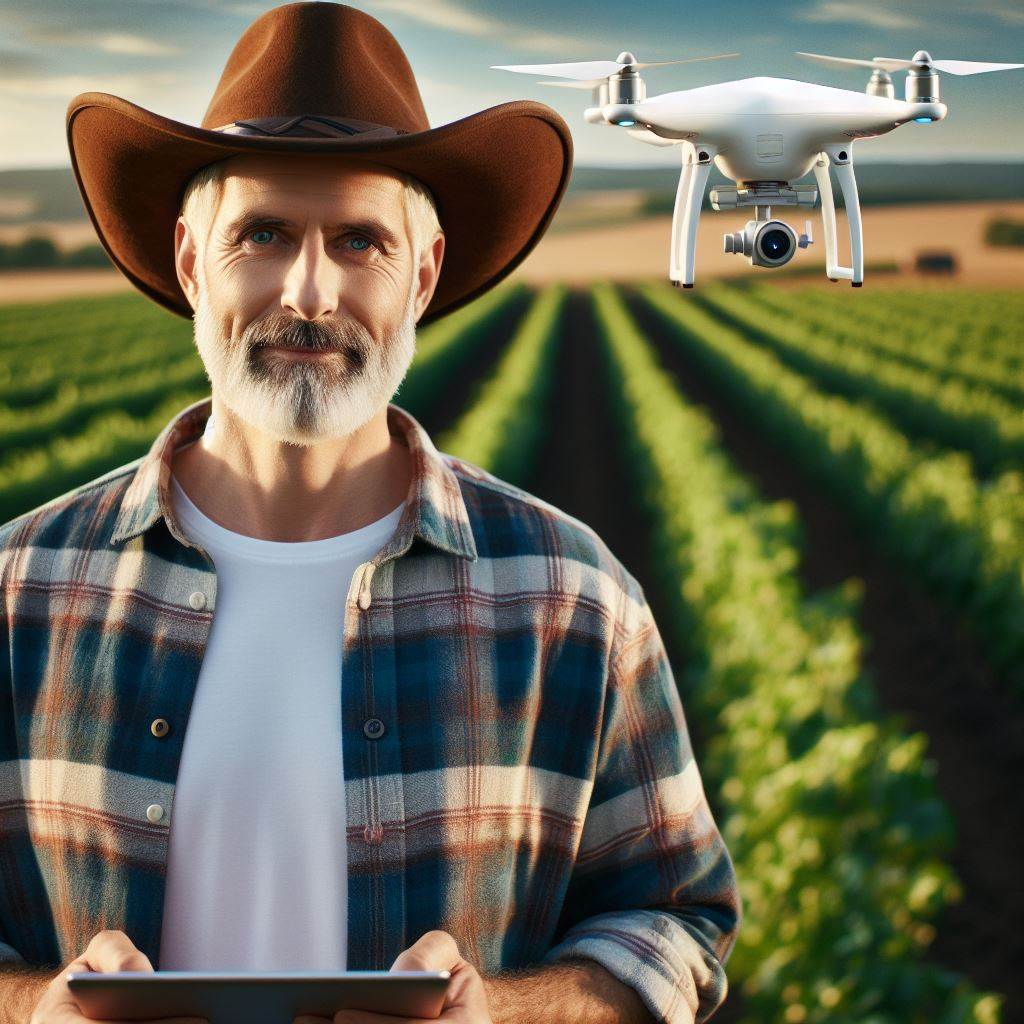Introduction
Moisture is a crucial factor in crop growth, affecting yield and quality.
Maintaining optimal moisture levels is essential for maximizing crop productivity.
Moisture sensors play a vital role in monitoring and optimizing crop yield.
These sensors are designed to accurately measure soil moisture levels at various depths.
By providing real-time data, moisture sensors enable farmers to make informed irrigation decisions.
They help prevent under or over-watering, which can lead to water and fertilization wastage, disease, and reduced crop production.
Moisture sensors aid farmers in determining the exact amount and timing of irrigation required for different crops.
This helps avoid water stress and promotes healthy root development, leading to increased nutrient uptake and overall crop resilience.
Furthermore, moisture sensors improve the efficiency of irrigation systems by allowing farmers to automate irrigation processes.
This saves time and resources while ensuring that crops receive the appropriate amount of water consistently.
Moreover, these sensors provide valuable insights into soil moisture distribution across fields, helping farmers identify areas that need additional irrigation or drainage.
This allows for targeted water management, reducing water usage and environmental impact.
Overall, moisture sensors are valuable tools in modern agriculture, enabling farmers to optimize crop yield and make efficient use of resources.
By monitoring and maintaining optimal moisture levels, farmers can improve crop quality, reduce water wastage, and increase overall agricultural sustainability.
Definition and Types of Moisture Sensors
Moisture sensors play a crucial role in agriculture by helping farmers optimize crop yields and conserve water resources.
These sensors detect the moisture content in the soil, providing valuable information for effective irrigation practices.
A. Explanation of moisture sensors
Moisture sensors are devices that measure the amount of water present in a particular medium, such as soil.
They work by sensing the changes in electrical conductivity or dielectric properties caused by variations in moisture levels.
B. Different types of moisture sensors
- Soil moisture sensors: Farmers insert sensors into soil, measuring moisture at various depths and providing real-time data for irrigation adjustments.
- Tensiometers: Tensiometers measure soil moisture tension by gauging water retention force using a hollow tube filled with water and a porous ceramic cup.
- Capacitance sensors: Capacitance sensors gauge soil moisture by measuring electrical capacitance changes between two electrodes, which vary with moisture levels.
- Time domain reflectometers (TDR): TDR sensors emit electromagnetic pulses into the soil, measuring reflection time affected by moisture content for estimating moisture levels.
- Neutron probes: Neutron probes assess soil moisture by measuring neutron count rate emitted by a radioactive source, slowed by soil moisture.
These different types of moisture sensors offer various advantages and are suitable for different agricultural applications.
Soil moisture sensors provide continuous data, allowing farmers to monitor moisture levels in real-time.
They help prevent over-irrigation, which can lead to waterlogged soil and root rot.
Tensiometers are useful in determining when to irrigate, as they indicate when soil moisture tension reaches a certain threshold.
This prevents under or over-irrigation, ensuring optimal soil moisture levels for plant growth.
Capacitance sensors are non-invasive and can be placed at different locations in the field.
They provide information on soil moisture distribution, allowing farmers to identify areas that require additional irrigation.
TDR sensors are highly accurate and can measure soil moisture at different depths.
They are suitable for precision agriculture, as they provide detailed information on moisture profiles.
Neutron probes are used for research purposes and provide highly accurate readings.
However, they require specialized training and are not commonly used by farmers.
In short, moisture sensors are essential tools for farmers looking to optimize crop yields and save water.
By utilizing different types of moisture sensors, farmers can make informed decisions regarding irrigation practices, resulting in improved productivity and resource efficiency.
Transform Your Agribusiness
Unlock your farm's potential with expert advice tailored to your needs. Get actionable steps that drive real results.
Get StartedRead: Irrigation Apps: Tech at Your Fingertips
Benefits of Using Moisture Sensors
Moisture sensors are a valuable tool for farmers and gardeners alike, providing numerous benefits in crop production.
By using moisture sensors, farmers can greatly increase their crop yields.
These sensors allow farmers to monitor and control the water content in their fields, which is crucial for crop growth.
A. Increased crop yield
One of the main benefits of using moisture sensors is the increased crop yield.
By ensuring that the soil moisture levels are at optimal levels, farmers can promote healthy plant growth and enhance the overall productivity of their crops.
This leads to higher yields and more successful harvests.
B. Water savings
Another significant benefit is water savings.
By using moisture sensors, farmers can determine the exact amount of water their crops need, eliminating unnecessary water usage.
This not only helps to conserve water, but also reduces water costs for farmers.
Additionally, water savings contribute to environmental sustainability by reducing the strain on water resources.
C. Optimal irrigation scheduling
Moisture sensors also allow for optimal irrigation scheduling.
These sensors measure the moisture levels in the soil and provide real-time data to farmers.
Based on this information, farmers can determine the best time to irrigate their crops, preventing overwatering or underwatering.
This precise irrigation scheduling helps to maintain the ideal moisture levels for crop growth and maximizes the efficiency of water usage.
D. Enhanced soil health and water infiltration
Preventing overwatering or underwatering is crucial for crop health.
Overwatering can lead to root rot, disease, and nutrient leaching, while underwatering can result in stunted growth and yield reduction.
Moisture sensors provide accurate readings, enabling farmers to avoid these problems and ensure the proper moisture levels for their crops.
E. Improved nutrient management
- Moisture sensors also contribute to improved nutrient management.
- By monitoring the soil moisture levels, farmers can adjust their fertilizer applications accordingly.
- This allows for more efficient nutrient uptake by the plants, reducing the risk of nutrient deficiencies or excesses.
- Proper nutrient management leads to healthier and more productive crops.
- In addition to crop benefits, moisture sensors also positively impact soil health and water infiltration.
- By maintaining the optimal moisture levels, these sensors promote better soil structure and aeration.
- This, in turn, enhances water infiltration and reduces the risk of soil erosion.
- Improved soil health contributes to long-term sustainability and the overall health of the farming ecosystem.
In general, the use of moisture sensors provides a wide range of benefits for crop production.
Increased crop yield, water savings, optimal irrigation scheduling, prevention of overwatering or underwatering, improved nutrient management, and enhanced soil health are among the advantages of using these sensors.
By integrating moisture sensors into their farming practices, farmers can optimize their crop production, conserve water resources, and promote sustainable agriculture.
Read: 2024’s Top Smart Irrigation Systems Reviewed
How Moisture Sensors Work
Moisture sensors play a crucial role in boosting crop yields by providing accurate information about soil moisture levels.
These sensors work by measuring the amount of water in the soil and transmitting the data to a monitoring system.
A. Soil moisture monitoring
- Soil moisture monitoring is a key aspect of using moisture sensors effectively.
- It involves placing the sensors at different depths in the soil to capture a comprehensive picture of moisture distribution.
B. Placement of sensors
- The placement of sensors depends on the specific crop and its root depth.
- Typically, sensors are installed at different depths ranging from shallow to deep to monitor moisture availability across the entire root zone.
C. Data collection frequency
- Data collection frequency is another important consideration.
- Moisture sensors can be programmed to collect data at regular intervals, such as every hour, every day, or every week, depending on the crop’s water requirements.
D. Interpretation of data
- Interpretation of data collected by moisture sensors is critical for making informed irrigation decisions.
- The sensor data can provide insights into whether the soil is too dry or too wet, helping farmers optimize watering schedules.
E. Connecting Sensors to Irrigation Systems
- Connecting moisture sensors to irrigation systems enables automation and remote monitoring.
- This integration allows for more efficient water usage and reduces the risk of over or under irrigation.
F. Automation and remote monitoring
- Automation involves using sensor data to control irrigation systems.
- When moisture levels drop below a certain threshold, the sensor sends a signal to activate the irrigation system, providing water to the crop in a timely manner.
G. Automation and remote monitoring
- Remote monitoring is another feature facilitated by connecting sensors to irrigation systems.
- Farmers can access real-time data on soil moisture levels from anywhere, using mobile applications or online platforms.
H. Adjusting irrigation schedules based on sensor data
- Adjusting irrigation schedules based on sensor data is a significant advantage of using moisture sensors.
- Farmers can fine-tune their irrigation programs according to actual soil moisture conditions, saving water and reducing operational costs.
In fact, moisture sensors are powerful tools for boosting crop yields by ensuring optimal soil moisture levels.
Understanding how these sensors work, their placement in the soil, data collection frequency, interpretation of data, and their integration with irrigation systems is crucial for their effective utilization in agriculture.
By embracing these advancements in technology, farmers can make informed decisions about irrigation, conserve water resources, and ultimately increase their productivity.
Read: Farming Data: AI’s Analytical Power

Challenges and Considerations in Using Moisture Sensors
Using moisture sensors in agriculture can greatly improve crop yields and efficiency.
However, like any technology, there are challenges and considerations that need to be addressed in order to maximize the benefits.
Let’s take a look at some of these challenges and considerations.
A. Cost of sensors and equipment
- Moisture sensors and related equipment can be expensive, especially for large-scale farming operations.
- Investing in high-quality sensors is crucial to ensure accurate and reliable measurements.
- Additional costs may include installation, maintenance, and replacement of sensors.
B. Calibration requirements
- Moisture sensors need to be calibrated regularly to provide accurate readings.
- Calibration requires time and expertise to ensure proper functioning of the sensors.
- External factors such as temperature and pH levels can affect sensor calibration.
C. Sensor reliability and maintenance
- Sensor reliability is vital for making informed irrigation decisions.
- Regular maintenance is necessary to prevent sensor malfunction or inaccuracies.
- Checking for physical damage, corrosion, or wear and tear is essential for optimal performance.
D. Compatibility with different soil types
- Moisture sensors may work differently depending on the soil type they are installed in.
- Soil composition, texture, and density can affect the accuracy of moisture measurements.
- Understanding the specific requirements of different soil types is crucial for effective sensor implementation.
E. Data interpretation and understanding crop needs.
- Collecting data from moisture sensors is only valuable if it can be properly interpreted and acted upon.
- Understanding the water needs of different crops based on sensor readings is essential.
- Proper training and knowledge are necessary to make informed irrigation decisions.
- Sensor data should be analyzed in conjunction with weather forecasts and other relevant factors.
Despite these challenges and considerations, using moisture sensors can significantly benefit crop production.
By monitoring soil moisture levels accurately, farmers can optimize irrigation, minimize water waste, and ensure healthier plant growth.
To make the most of this technology, it is important to invest in reliable sensors, regularly calibrate them, and maintain them properly.
Additionally, understanding the specific requirements of different soil types and interpreting sensor data correctly are crucial for achieving optimal outcomes.
Although there may be obstacles to overcome, the rewards in terms of increased crop yields and resource efficiency make the use of moisture sensors in agriculture well worth it.
Read: Automated Irrigation: Saving Water & Time
Success Stories and Case Studies
As moisture sensors become more commonly used in agriculture, farmers all around the world are sharing their experiences and success stories with these innovative technologies.
By using moisture sensor applications, they have been able to increase crop yields while saving water.
In this section, we will explore some of these success stories, the lessons learned, and best practices shared by farmers.
A. Farmers and Their Experiences with Moisture Sensor Applications
Farmers from different regions have reported positive outcomes after implementing moisture sensor applications in their fields.
For example, John, a farmer from California, started using moisture sensors to monitor irrigation levels in his vineyard.
By regularly checking the moisture levels in different areas of his vineyard, he was able to optimize the irrigation process and ensure that each plant received the right amount of water.
Similarly, Maria, a farmer from Argentina, used moisture sensors to improve her potato crops.
She had been struggling with water management, often over-irrigating or under-irrigating her fields.
However, after implementing moisture sensors, she was able to accurately measure the soil moisture content and adjust her irrigation accordingly.
This resulted in healthier potato plants and increased yields.
B. Increased Crop Yields and Water Savings Achieved
The use of moisture sensors has consistently shown positive impacts on crop yields and water savings.
Many farmers have reported significant increases in their yields after implementing these technologies.
By ensuring that crops receive the optimal amount of water at different growth stages, farmers have been able to enhance the overall health and productivity of their plants.
In addition to increased crop yields, farmers have also witnessed substantial water savings.
Previously, water was often wasted through over-irrigation or inefficient watering methods.
However, with the help of moisture sensors, farmers can accurately track and measure soil moisture levels, allowing them to adjust their irrigation systems accordingly.
This not only reduces water waste but also leads to cost savings for farmers.
C. Lessons Learned and Best Practices Shared
Through their experiences with moisture sensor applications, farmers have learned valuable lessons and developed best practices to optimize their use.
One common lesson shared by farmers is the importance of proper sensor placement.
Placing sensors in representative locations within the field ensures accurate readings and allows for efficient irrigation management.
Farmers have also emphasized the need for regular maintenance and calibration of moisture sensors.
Over time, sensor accuracy may decrease due to factors like soil compaction or sensor drift.
Regular maintenance and calibration help ensure reliable data collection and precise irrigation decisions.
Showcase Your Farming Business
Publish your professional farming services profile on our blog for a one-time fee of $200 and reach a dedicated audience of farmers and agribusiness owners.
Publish Your ProfileAnother best practice shared by farmers is the integration of moisture sensors with digital farming tools and technologies.
By connecting moisture sensors to weather stations, irrigation control systems, and mobile applications, farmers can access real-time data and make informed irrigation decisions remotely.
Essentially, moisture sensors have proven to be effective tools in boosting crop yields and water savings.
Farmers worldwide are sharing their success stories and experiences with moisture sensor applications.
Increased crop yields, water savings, and valuable lessons learned have demonstrated the positive impact of these technologies in agriculture.
Conclusion
Moisture sensors play a crucial role in boosting crop yields for farmers.
They provide valuable data on soil moisture levels, helping farmers make informed decisions about irrigation and water management
They save water and energy, reduce irrigation costs, and promote sustainable farming practices.
Therefore, it is highly encouraged for farmers to consider implementing moisture sensor technology on their farms.
It can have a significant impact on crop productivity, leading to higher yields and increased profits.
Looking ahead, the future prospects for moisture sensor technology are promising.
Advancements in sensor technology, data analysis, and connectivity will further enhance their capabilities.
Farmers can expect more accurate and real-time data, improved sensor durability, and increased compatibility with other farming technologies.
With the continuous development and adoption of moisture sensor technology, farmers can look forward to increased efficiency, reduced resource wastage, and improved overall crop management.
In closing, moisture sensors are a game-changer for modern farming, and farmers should embrace this technology to maximize their crop yields and overall success.




